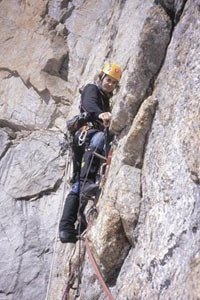
S?lvia Vidal on the first ascent of Mai Blau (A3+ 6b 70?, 890m) on Neverseen Tower, Garhwal Himalaya, India. The route took thirteen days to establish, but the crux was the two weeks trapped at base camp by a storm with only a single fuel canister. Vidal is the most accomplished female big-wall climber in the world; her 1999 first ascent of Amin Brakk, via the route Sol Solet (VII 6c+ A5 60?, 1650m) with Miquel Puigdom?nech and Pep Masip, is regarded as one of the harder Greater Range wall routes. [Photo] Silvia Vidal
When Eloi Callado and I traveled to the Miyar Valley in September to climb a route on the west face of Neverseen Tower (ca. 5700m), neither of us expected a crazy adventure. A 400-meter snow ramp (35-40 degrees) took us to the base of the wall. We fixed a couple of pitches, then moved onto the wall, where we followed a natural line on the left side of the main (west) face. We spent thirteen days (twelve bivouacs) establishing our route, placing bolts only at the belays. We used ice tools to climb Pitch 13 (65 degrees) and the last 150 meters of a ridge, then bouldered the highest point: a rock block. The result was a route with thirteen pitches, some of which were more than seventy meters long, that we called Mai Blau, Catalan for Never Blue (A3+ 6b 70 degrees, 890 meters, not including the snow ramp).
The name came from the bad weather. It was cold, and sometimes it clouded over, but nothing unusual. So when we rapped the route and it started snowing, we didn’t think much about it.
Assuming that the next day we could go back up to recover the rest of the gear, we brought only one haulbag each on the descent. We left the gear under a big block at the top of the snow ramp. Back at the glacier tent, we had only our portaledge, stove and one fuel canister.
Three days of nonstop snow stranded us at base camp for the next two weeks. We were alone, without any technology with which to contact the outside world. We had twenty days to go before our flight home, but we were still afraid we would miss our plane. Why? To get home we needed to catch the bus to Delhi from Manali, the closest big town. To get to Manali, though, we needed to cross Rothang Pass, which was at the same altitude (4800m) as base camp, where we had one and a half meters of new snow. We thought that the road would be closed.
Two weeks after the climb, after digging out our tent with ice axes, we managed to descend to the main valley. We arrived at the small village of Udaipur and got a four-wheel-drive car to cross the pass. But two kilometers before the pass, we encountered a long line of cars. We spent hours waiting; finally our driver abandoned us. Climbing a big wall in bad conditions is hard, the days at base camp with little fuel and much doubt were harder, but walking through the mountains where there used to be a road and running behind a truck to hitch a ride was too much….
But now is the time to laugh about it!
— Silvia Vidal, Barcelona, Spain